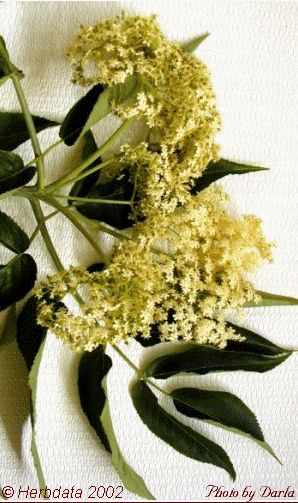
Elderberry USD 1926
SAMBUCUS. N. F. SAMBUCUS
Sambuc. [Elder Flowers]
Compiled by Ivor Hughes
" Sambucus is the air-dried flower of Sam-bucus canadensis Linne, or of Sambucv-s nigra Linne (Fam. Caprifoliaceae). Sambueus contains not more than 2 per cent, of foreign organic matter." N. F.
Elder; Sambuci Flores, Br., 1898; Sweet Elder; Black Elder; Bureau, Fleurs de Bureau, Fr.; Flores Sambuci, P. G.; Hol-under, Fliederblumen, G.; Sambuco, It.; Sauco, Sp.
The indigenous common elder, Sambucus
canadensis, is a shrub from six to twelve feet high, with a branching stem,
covered with a rough gray bark, and containing a large spongy pith. The
small branches and leaf-stalks are very smooth. The leaves are opposite, and
pinnately compound with usually seven leaflets The flowers are small, white,
and disposed in loose cymes; the cream-colored corolla is wheel-shaped, with
five stamens on the tube. The fruits are small, globular, black berry-like
drupes which are edible when mature. The shrubs grow in low, moist grounds,
along fences,and on the borders of small streams, throughout the United
States, from Canada to the Caro-linas, and westward as far as Arizona and
Texas. It flowers from May to July, and ripens its fruit early in autumnThe
Sambucus nigra, of Europe, differs from the American most obviously in its
size, approaching in height that of a small tree. The stem is much branched
towards the top, and has a rough whitish bark. The leaves may show 3-7
leaflets but usually possess 5. The flowers are small, whitish and in
five-parted cymes. The ovary consists of but three carpels, there being
usually four cells in S. canadensis L. The berries are large in the European
elder, globular, and blackish-purple when ripe. G. De Sanetis (Gaze. Chim.
Ital., 1895, xxv, 1, vol. xlix) obtained eoniine from the leaves and stems
of Sambucus nigra.
 The
flowers have an aromatic though rather heavy odor. The berries as well as
other parts of the plant are employed in domestic practice.
The
flowers have an aromatic though rather heavy odor. The berries as well as
other parts of the plant are employed in domestic practice.
Description and Physical Properties.� " Small, from 2 to 3 mm. in width, shriveled; calyx superior, five-lobed; corolla cream colored to brownish yellow, rotate, flat or slightly cam-panulate, regularly five-lobed; stamens five, inserted at the base of the corolla and alternating with its lobes, filaments lender, anthers oblong, yellow; pollen ellipsoidal or tetrahedral and rounded, covered with finely punctate markings, having three pores and up to 0.23 mm. in diameter, Odor faintly sweet and aromatic; taste slightly bitter." N. F.
The flowers yield their active properties to water by infusion, and when distilled give over a small proportion of volatile oil, which on cooling assumes a butyraeeous consistence and contains an appreciable portion of ammonia. The berries are nearly inodorous, but have a sweetish, acidulous taste, dependent on the presence of saccharine matter and malic acid. Their expressed juice is susceptible of fermentation, and forms a vinous liquor used in northern Europe. It is colored violet by alkalies, and bright red by acids, and the coloring matter is precipitated blue by lead acetate. The inner bark is without odor. The bark of the elder contains tannin, valeric (viburnic) acid, resin, etc. (Traub, A. J. P., 1881, p. 392). The resin, according to Simon (Ann. Pharm., xxxi, p. 262), in doses of twenty grains is cathartic and emetic. Lloyd found in the flowers a white substance�eldrin, which turned a deep yellow on the addition of alkalies which he believed to be the coloring matter of white flowers (A. J. P., 1921, xciii, p. 40). As far as we know, no substance has been found in the flowers suggesting any physiologically active principle. J. B. Metzgar made a partial examination of the fruit and found sugar, gum, tannin, fat, and a resinous body. (A. J. P., 1881, p. 553.) It was also examined by F. F. Lyons (A. J. P., 1892, p. 1), who found 0.5 per cent, of a volatile oil, an amorphous yellow compound of a glucosidal character, and a tannin. The volatile oil of elder flowers was examined by W. J. Bush & Co. (C. D., 1897, 53.) It has the sp. gr. 0.827, and is solid at ordinary temperatures like oil of rose. The liquid portion possesses the fragrance of fresh elder blossoms. �<,�,.
Uses. - Elder flowers have been esteemed dia* phoretic and diuretic and used in febrile complaints and also as an alterative in syphilis and rheumatism. There is, however, no reason to suspect that they possess any real curative properties. The berries, bark and root, however, appear to possess some laxative principles and especially the last named has been used as a hydragogue in dropsy.
Dose, from thirty to sixty grains (2-4 Gm.). Off.Prep.Fluidextractum Stillingite Compositum,N.F.; Species Laxative,N.F.; Syrupus Stillingiro Compositus, N.F.
![]()